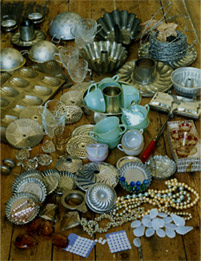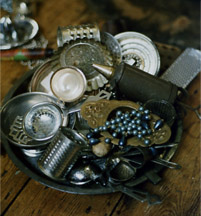Making
Making Teacup Chandeliers
When I started to gather other things to make a structure with, I discovered that all the things I needed were already there just waiting for me to assemble them. I searched in charity shops, car boot sales and scrap metal yards. I don't remember ever making a decision to use kitchen items I just found that they supplied so many useful forms, like circular metal objects - sometimes already with holes in. I prefer to work with things I've found and let their qualities dictate what happens. A piece begins with a really simple set of ideas, a shape, a colour combination and the objects I want to use. I liked the idea of making something opulent - a chandelier - but out of humble objects.
Making things by reusing satisfies many needs and provides a framework to be inventive within. For me it's a challenge, what can I find that's been discarded that could be used for something else? Old kitchen utensils are really familiar objects but to me not very useful in their traditional role. I've never used a pastry cutter for pastry or a toast rack for toast but they seem nice jaunty objects with more potential, so I liberate them from their domestic duties by incorporating them in my chandeliers.
I find trifle moulds and crinkly cutters really humorous implements, who decided they should be crinkly? And toast racks are perhaps the most absurd, what better way to cool down your toast too quickly than sit them in a rack so they're no longer able to melt the butter.

Recycling
Recycling re-emerges regularly in other popular styles like customising, vintage, eclectic, salvage, collage, sampling etc., and in all mediums whether furniture making, design graphics, music or fine art. Using something that had a previous life can create interest and depth as well as being pragmatic.
Recycling has been around forever, born of a need and not having the luxury to waste but coupled with a basic human desire to create, recreate and entertain and I like to think that my work is part of this age old tradition.

